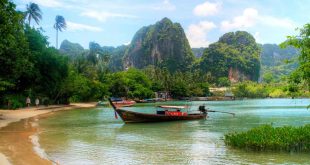Taking a Chardham Yatra is more than just a pilgrimage, it’s an experience of great renewal of soul and spiritual reconnection with the holy. The four holy sites of Uttarakhand—Yamunotri, Gangotri, Kedarnath, and Badrinath—are visited in this holy journey, also called the 4 Dham Yatra. In addition to their religious significance, each of these locations is notable for the breathtaking natural beauty that wraps them.
1. Yamunotri – The Source of Yamuna River
Yamunotri, the first station on the Chardham Yatra, is the source of the sacred river Yamuna. Located at an altitude of 3,293 meters, Yamunotri provides not only spiritual consolation but also a breathtaking view of the snow-capped Himalayas. The main attraction here is the temple devoted to the Goddess Yamuna.
Must-See Attractions in Yamunotri
- Surya Kund: This hot spring is named for the Sun God Surya, who is thought to be the father of Goddess Yamuna. Fans cook rice and potatoes in hot water before offering them to the deity.
- Saptrishi Kund: A glacier lake where it is said that the seven great sages (Saptrishis) did meditation. The walk to Saptrishi Kund is difficult yet rewarding, with a peaceful and clean scenery.
Gangotri – The Origin of the River Ganga
The next stop on the Chardham Yatra is Gangotri, the birthplace of the River Ganga. Gangotri, located at an elevation of 3,100 meters, is surrounded by the breathtaking Garhwal region Himalayas. The Gangotri Temple, dedicated to the Goddess Ganga, stands near the river and serves as an attraction for pilgrims. Imagine tracing the path of a river that feeds half of India! https://dailybloggernews.com
Bhagirath Shila at Gangotri
Bhagirath Shila is a famous rock near Gangotri temple where King Bhagirath is believed to have meditated to bring the Ganga down from heaven. This location is more than just a place of worship, it also represents power and commitment.
Gaumukh Glacier Hike in Gangotri
For the daring, the Gaumukh Glacier hike is a remarkable experience. Gaumukh, the actual source of the Ganges, is around 19 kilometers from Gangotri. The hike provides a breathtaking view of the glacier and neighboring peaks, giving it the ideal combination of spirituality and action.
Kedarnath is the abode of Lord Shiva.
Kedarnath Temple
Adi Shankaracharya created the Kedarnath Temple in the eighth century, and it serves as a testimony to traditional Indian architecture and spirituality. The temple is said to be built on the spot where Lord Shiva appeared in the form of a Jyotirlinga. The temple’s majestic beauty against the backdrop of snow-capped peaks is breathtaking.
Vasuki Tal at Kedarnath
Vasuki Tal, a high-altitude lake at an elevation of 4,150 meters, is another Kedarnath jewel. The climb to Vasuki Tal is difficult, but it provides an amazing vista of the Chaukhamba hills and the lake’s calm waters. https://dailybloggernews.com
Badrinath: The Abode of Lord Vishnu
A Sacred Pilgrimage Site
The Badrinath Temple, believed to have been established by Adi Shankaracharya in the ninth century, is a renowned pilgrimage site for Hindus. The temple houses a black stone idol of Lord Vishnu, also referred to as Badri Vishal, which is regarded as one of Vishnu’s eight swayam vyakta kshetras (self-manifested statues).
The Ritual of Tapt Kund
Before entering the temple, devotees cleanse themselves by taking a holy dip in Tapt Kund, a natural hot spring located at the base of the temple. The warm waters of the Kund are believed to possess healing properties and offer a soothing respite from the chilly weather of Badrinath.
The Majestic Neelkanth Peak
The Badrinath Temple is surrounded by the breathtaking Neelkanth Peak, standing tall at 6,597 meters. This peak, often referred to as the ‘Garhwal Queen,’ is illuminated by the golden sunlight during sunrise, creating a mesmerizing sight.
FAQs
1. What is the best time to undertake the Chardham Yatra?
The best time to undertake the Chardham Yatra is from April to June and from September to November. During these months, the weather is pleasant, and the routes are accessible.
2. How can I prepare physically for the Chardham Yatra?
It’s advisable to start with light exercises and gradually move to more rigorous workouts. Walking, jogging, and breathing exercises can help build stamina and endurance for the trek.
3. Are there medical facilities available on the Chardham route?
Yes, there are medical facilities available at various points along the Chardham route. However, it’s recommended to carry a personal medical kit and necessary medications.
4. How can I book a Char Dham, Teen Dham, or Do Dham Yatra Package?
You can book our Chardham Yatra By Road packages by contacting us through phone at +917534004088 or via email at info@pinalholidays.com. Alternatively, you can visit our office at 503 Neelpadam 2, Sector 4 Vaishali Ghaziabad, Uttar Pradesh 201019.
5. Can senior citizens and children undertake the Chardham Yatra?
Yes, senior citizens and children can undertake the Chardham Yatra. However, it’s important to consult a doctor and ensure they are physically fit for the journey.
6. What are the accommodation options available during the Chardham Yatra?
There are various accommodation options ranging from budget hotels to luxury lodges and guesthouses available along the Chardham route. It is advisable to book in advance, especially during the peak season.
Conclusion
The Chardham Yatra, also known as the 4 Dham Yatra, is a journey that goes beyond the physical and touches the soul. Each of the four dhams—Yamunotri, Gangotri, Kedarnath, and Badrinath—provides a distinct combination of spiritual significance and natural beauty. Whether it’s the serenity of Yamunotri, the heavenly aura of Gangotri, the majestic vibrations of Kedarnath, or the bright spirituality of Badrinath, each step of this pilgrimage brings you closer to spiritual wisdom
 Daily Blogger News Stay updated with the latest trends and insights. Your reliable source for daily updates and information.
Daily Blogger News Stay updated with the latest trends and insights. Your reliable source for daily updates and information.






